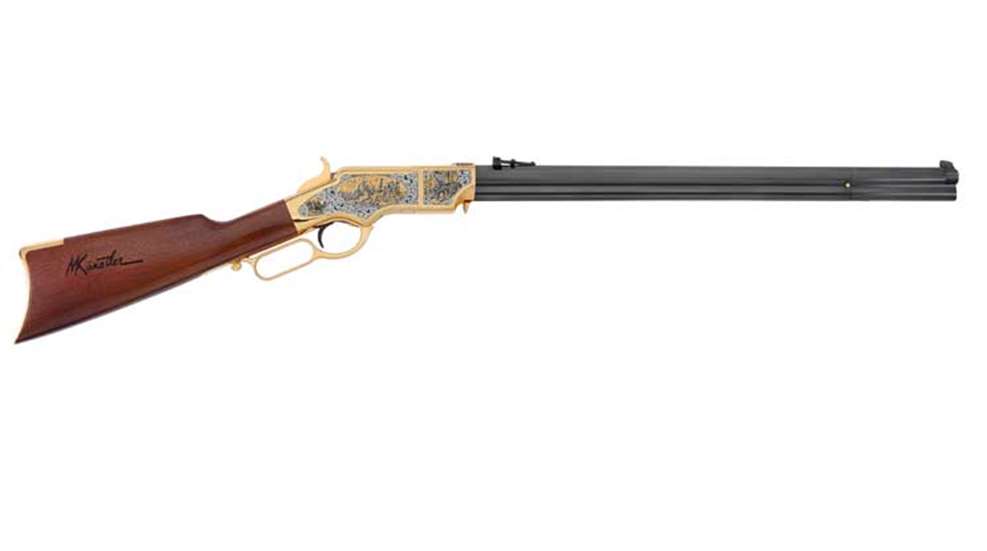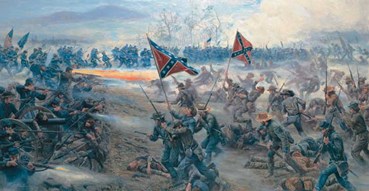
America Remembers, in its efforts to ensure that future generations never forget our nation’s history. is offering a Mort Künstler Gettysburg Tribute 1860 Henry Rifle, which is issued on a working recreation of the legendary 1860 Henry rifle in caliber .44-40, one of the most legendary long arms of the war. Each Tribute is a meticulously detailed working recreation of the Henry rifle in caliber .44-40, crafted by the artisans of A. Uberti. America Remembers has immortalized a collection of Mort Künstler’s most unforgettable images of Gettysburg and translated them into lustrous 24-karat gold artwork on a brushed nickel canvas on a classic firearm of the Civil War era, a firearm that would revolutionize military tactics and make single-shot rifles a weapon of the past. Historians have called Mort Künstler “America’s foremost historical artist and chronicler of the Civil War.” Over the last three decades, his artistic vision has literally changed how we see the Civil War. This Tribute represents an exciting opportunity for fans of Civil War history, fine art, and firearms.

On the left of the receiver is a recreation of “The Enemy is There!”, depicting General Lee and his staff arriving on horseback during the first day of fighting at Gettysburg. Lee was confident that his army would make short work of the Union soldiers and open a clear path to the North. Their offensive did break the Union lines and send the Federal troops running for the hills, but the decision by Confederates not to continue the attack gave Union troops a chance to fortify and regroup for the next day’s fighting.
Framed in the center oval is a detail from The High Water Mark showing the bold charge of Confederate troops against the Union lines. Waves of rebels marched across the open field in what would forever be known as “Pickett’s Charge.” You can see the determination on the faces of the Confederate soldiers as they charge headlong into the barrage of musket and cannon fire from the Union regiment. The main Confederate Army never advanced any further north than during the Gettysburg fighting. Therefore, Pickett’s Charge is considered the “high water mark” for the Confederate military.
Completing the trio on the left of the receiver is a selection from Longstreet at Gettysburg. The scene shows Confederate General James Longstreet approaching the battlefield with a group of his officers on horseback. Recognized as one of the most effective commanders of the war, Longstreet served alongside Lee during some of the South’s most important victories.

The right side highlights three additional Mort Künstler Gettysburg masterpieces. To the far left is a portion of Dilger at Gettysburg. The original painting captures the brave actions of Captain John Hubert Dilger, one of the most famous artillerists of the war. During the first day of fighting at Gettysburg, he ordered two of his big guns forward of the main battle line without infantry support, a daring and risky maneuver. Künstler’s expert touch brings the tense moment to life, depicting the bold captain and his men charging across open farmland pulling two big guns and the caisson with ammunition to obtain an advantageous position against Confederate guns on Oak Hill. At the center is a section of the epic, “Follow Me Boys!”, which shows Confederate General Lewis Armistead leading his brigade over the stone wall at “The Angle” on Cemetery Ridge. Reportedly, Armistead fixed his hat on the end of his sword and roused his troops by shouting, “remember what you are fighting for – your homes, your friends, your sweethearts!” The general was mortally wounded, but became an iconic figure of the Confederacy.
The final scene on the right receiver is from Hero of Little Round Top. At its center is the unmistakable figure of Colonel Joshua L. Chamberlain, standing with his saber raised, among the men of the 20th Maine. His troops were ordered to hold the left flank of the Union line “at all costs”. As the Confederates massed for a final assault on Little Round Top, Chamberlain gathered his troops for a bold counter-offensive. As the Southern soldiers marched up the incline, the last thing they expected was a wave of dark blue uniforms with fixed bayonets. The boys from Maine shattered the Confederate assault and helped turn the tide of the entire war. Künstler’s painting captures the instant when troops are ordered to fix bayonets. “I realized that the moment before Chamberlain’s famous charge was as dramatic as the charge itself,” he said.
The Henry Rifle: A Civil War Legend
The 1860 Henry rifle was a classic, lever-action firearm regarded by many as the most technologically advanced rifle available during the Civil War. The exceptional Henry was often purchased by Union soldiers at their own expense and this rarity made the revolutionary repeaters that much more of a treasure when obtained by Confederate forces. It was a repeater that used a .44 cal. metal-cased rimfire cartridge at a time when unreliable single-shot, ball and powder guns were still the norm. Each Henry rifle held up to 15 cartridges in the magazine, with room for another in the chamber. That kind of firepower made the Henry an engineering achievement in firearms efficiency and a powerful ally on the front lines.
Mort Künstler

Mort Künstler has captured the Civil War from all angles. From the chaos of an infantry battlefield charge to the gentle beauty of a Southern Belle, he has crafted a body of artwork with impressive scope. In Künstler’s paintings, he does not choose sides. His work encompasses both Union and Confederate battles, soldiers, and leaders. There are no villains, only American soldiers. Each of them earns the respect of the master’s brush.
To learn and see more of this rifle, please visit americaremembers.com.





































